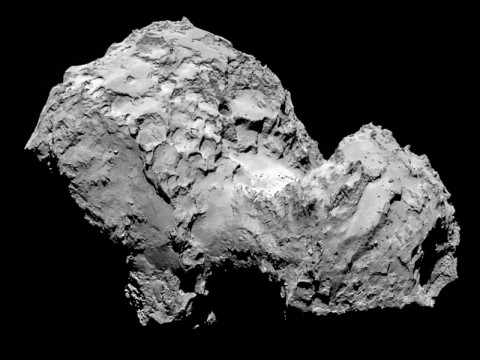Written by Tony Phillips
Science at NASA
 Washington, D.C. – Today, after a decade-long journey chasing its target, the European Space Agency’s Rosetta probe, carrying three NASA instruments, became the first spacecraft to rendezvous with a comet, 67P/Churyumov-Gerasimenko.
Washington, D.C. – Today, after a decade-long journey chasing its target, the European Space Agency’s Rosetta probe, carrying three NASA instruments, became the first spacecraft to rendezvous with a comet, 67P/Churyumov-Gerasimenko.
“After 10 years, five months and four days travelling towards our destination, looping around the sun five times and clocking up 6.4 billion kilometers, we are delighted to announce finally we are here,” said Jean-Jacques Dordain, ESA’s director General.

The comet is in an elliptical, 6.5-year orbit that takes it from beyond Jupiter at its farthest point, to between the orbits of Mars and Earth at its closest to the sun.
Rosetta will accompany the comet for over a year as it swings around the sun and back out towards Jupiter again.
Rosetta is 62 miles (100 kilometers) from the comet’s surface. Over the next six weeks, it will fly two triangular-shaped trajectories in front of the comet, first at the 62-mile (100-kilometer) altitude and then down at 31 miles (50 kilometers).
At the same time, the spacecraft’s suite of instruments will provide a detailed scientific study of the comet, scanning the surface to identify a target site for its comet lander, Philae. Eventually, Rosetta will attempt a close, near-circular orbit at 19 miles (30 kilometers) and, depending on the activity of the comet, may come even closer.

“Over the next few months, in addition to characterizing the comet nucleus and setting the bar for the rest of the mission, we will begin final preparations for another space history first: landing on a comet,” said Matt Taylor, Rosetta’s project scientist from the European Space Agency’s Science and Technology Centre in Noordwijk, The Netherlands.
As many as five possible landing sites will be identified by late August, before the primary site is identified in mid-September. The final timeline for the sequence of events for deploying Philae — currently expected for November 11th — will be confirmed by the middle of October.
The three U.S. instruments aboard the spacecraft are the Microwave Instrument for Rosetta Orbiter (MIRO), an ultraviolet spectrometer called Alice, and the Ion and Electron Sensor (IES). They are part of a suite of 11 science instruments aboard the Rosetta orbiter.
MIRO is designed to provide data on how gas and dust leave the surface of the nucleus to form the coma and tail that give comets their intrinsic beauty. Studying the surface temperature and evolution of the coma and tail provides information on how the comet evolves as it approaches and leaves the vicinity of the sun.
Alice will analyze gases in the comet’s coma, which is the bright envelope of gas around the nucleus of the comet developed as it approaches the sun. Alice also will measure the rate at which the comet produces water, carbon monoxide and carbon dioxide. These measurements will provide valuable information about the surface composition of the nucleus.
The instrument also will measure the amount of argon present, an important clue about the temperature of the solar system at the time the comet’s nucleus originally formed more than 4.6 billion years ago.
[youtube]https://www.youtube.com/watch?v=BUvrwPBSo3A[/youtube]
IES is part of a suite of five instruments to analyze the plasma environment of the comet, particularly the coma. The instrument will measure the charged particles in the sun’s outer atmosphere, or solar wind, as they interact with the gas flowing out from the comet while Rosetta is drawing nearer to the comet’s nucleus.
NASA also provided part of the electronics package for the Double Focusing Mass Spectrometer, which is part of the Swiss-built Rosetta Orbiter Spectrometer for Ion and Neutral Analysis (ROSINA) instrument.
ROSINA will be the first instrument in space with sufficient resolution to be able to distinguish between molecular nitrogen and carbon monoxide, two molecules with approximately the same mass. Clear identification of nitrogen will help scientists understand conditions at the time the solar system was formed.
Launched in March 2004, Rosetta was reactivated in January 2014 after a record 957 days in hibernation. Composed of an orbiter and lander, Rosetta’s objectives upon arrival at comet 67P/Churyumov-Gerasimenko in August are to study the celestial object up close in unprecedented detail, prepare for landing a probe on the comet’s nucleus in November, and track its changes as it sweeps past the sun.
The latest images of the comet taken by Rosetta are available at http://www.nasa.gov/rosetta
The scientific imaging system, OSIRIS, was built by a consortium led by the Max Planck Institute for Solar System Research (Germany) in collaboration with Center of Studies and Activities for Space, University of Padua (Italy), the Astrophysical Laboratory of Marseille (France), the Institute of Astrophysics of Andalusia, CSIC (Spain), the Scientific Support Office of the European Space Agency (Netherlands), the National Institute for Aerospace Technology (Spain), the Technical University of Madrid (Spain), the Department of Physics and Astronomy of Uppsala University (Sweden) and the Institute of Computer and Network Engineering of the TU Braunschweig (Germany). OSIRIS was financially supported by the national funding agencies of Germany (DLR), France (CNES), Italy (ASI), Spain, and Sweden and the ESA Technical Directorate.
Rosetta is an ESA mission with contributions from its member states and NASA. Rosetta’s Philae lander is provided by a consortium led by the German Aerospace Center, Cologne; Max Planck Institute for Solar System Research, Gottingen; French National Space Agency, Paris; and the Italian Space Agency, Rome. JPL, a division of the California Institute of Technology, Pasadena, manages the U.S. participation in the Rosetta mission for NASA’s Science Mission Directorate in Washington.


